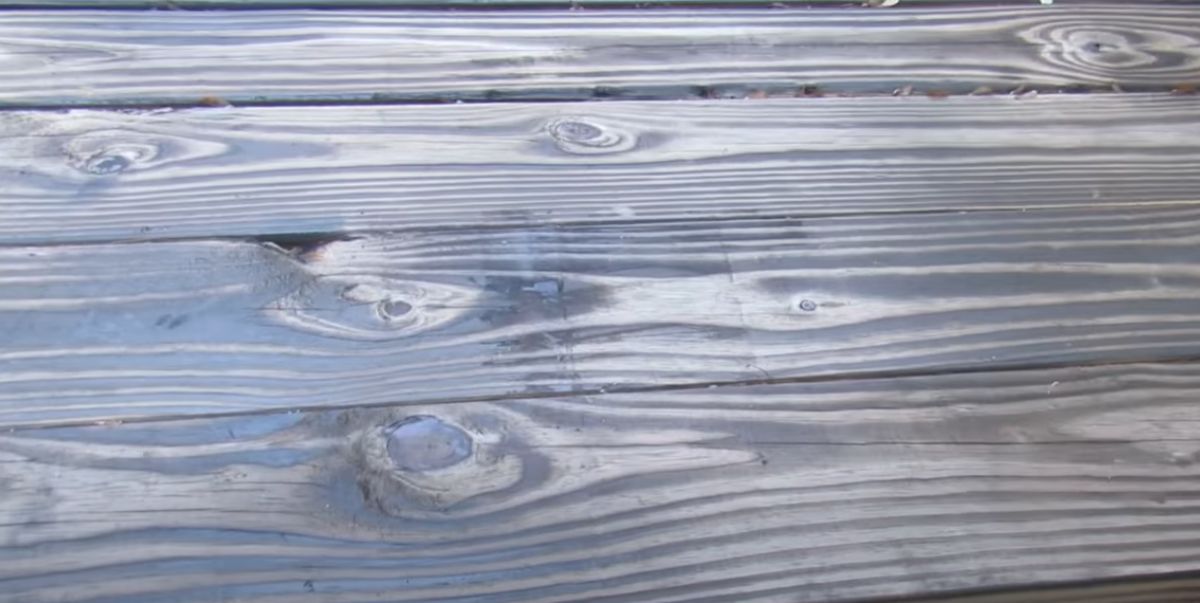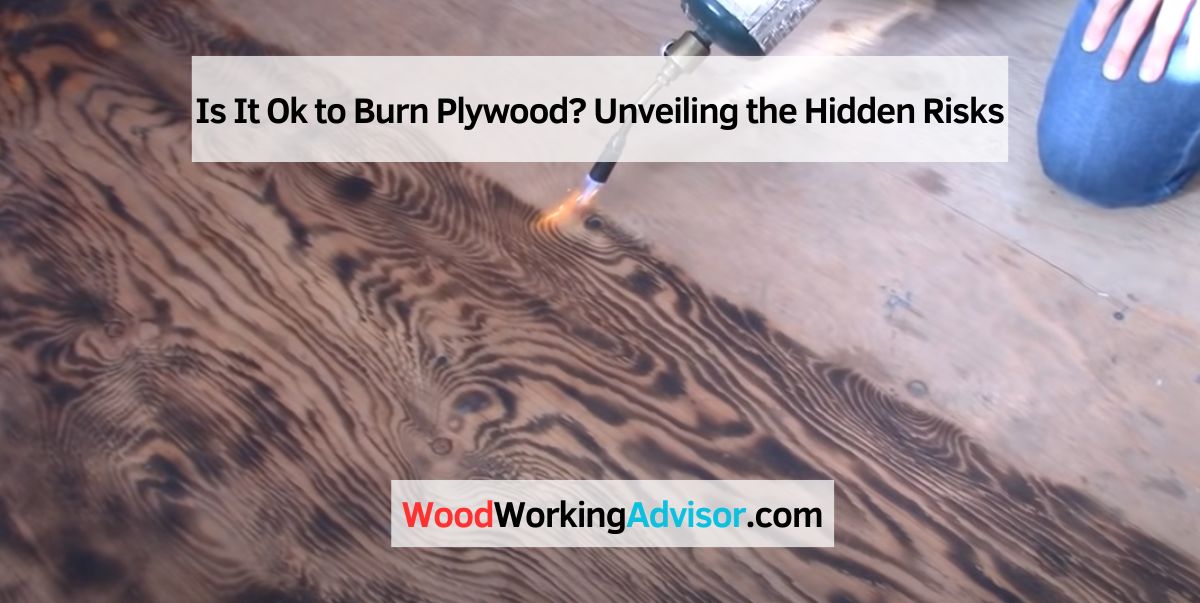Burning plywood is not recommended due to the potential release of toxic fumes. When plywood is burned, it can release harmful chemicals such as formaldehyde and dioxins, which can have negative health effects when inhaled.
These chemicals can cause respiratory issues, eye and skin irritation, and even long-term health problems. Plywood is a composite wood product made up of multiple layers of wood veneer glued together. The glues used in plywood production often contain formaldehyde, a known carcinogen.
When plywood is burned, the heat breaks down the glues and releases formaldehyde into the air, posing a health risk to those in close proximity. In addition to formaldehyde, burning plywood can also generate dioxins, which are highly toxic and can persist in the environment for years. Dioxins have been linked to reproductive and developmental problems, immune system disorders, and even certain types of cancer. Considering the potential health risks associated with burning plywood, it is best to avoid using it as a fuel source. Proper disposal methods should be followed to prevent the release of these harmful substances into the environment.
The Dangers Of Burning Plywood
Burning plywood may seem like a convenient way to get rid of excess materials or create warmth in a pinch, but it is important to understand the potential dangers associated with this practice. Not only can burning plywood release toxic fumes, but it also has a significant impact on air pollution. In this article, we will delve into these dangers and why you should avoid burning plywood.
Toxic Fumes Release
Burning plywood can release a harmful concoction of toxic fumes into the air, posing serious health risks. The glue used in plywood typically contains formaldehyde, a known carcinogen. When burned, formaldehyde vaporizes and mixes with other byproducts to form a toxic gas called formaldehyde gas.
Inhaling formaldehyde gas can lead to a range of health issues, including respiratory problems, eye and throat irritation, and even increased risk of cancer. These risks are amplified when plywood is burned indoors or in poorly ventilated spaces, as the concentration of toxic fumes becomes much higher.
Air Pollution Impact
Burning plywood contributes significantly to air pollution, negatively impacting both human health and the environment. When plywood burns, it releases a cocktail of pollutants into the air, such as carbon monoxide, nitrogen oxides, sulfur dioxide, and particulate matter.
| Pollutant | Effect |
|---|---|
| Carbon Monoxide | Reduces oxygen-carrying capacity of blood, leading to health problems |
| Nitrogen Oxides | Contributes to smog formation and respiratory issues |
| Sulfur Dioxide | Causes respiratory problems and contributes to acid rain |
| Particulate Matter | Small airborne particles that can enter the lungs and cause respiratory and cardiovascular problems |
These pollutants not only have direct harmful effects on human health but also contribute to the deterioration of air quality and the exacerbation of climate change.
Considering the toxic fumes and air pollution released when burning plywood, it is crucial to find alternative disposal methods and heating sources that are safer and more environmentally friendly. By doing so, you can protect your health, improve air quality, and contribute to a more sustainable future.
Alternatives To Burning Plywood
When it comes to burning plywood, it’s not recommended due to the harmful chemicals released. Instead, consider recycling or repurposing plywood, or using alternative materials for fuel. This not only helps reduce environmental impact but also prevents health hazards associated with burning plywood.
Burning plywood is not recommended due to the potential release of toxic chemicals into the air. If you’re wondering what to do with your old or unused plywood, there are several environmentally friendly alternatives you can consider. These alternatives not only help prevent pollution but also contribute to a more sustainable future.
Recycling Options
- 1. Wood Recycling Centers: Recycling centers dedicated to wood materials can take in old or used plywood. They have the proper facilities and processes in place to separate and recycle different types of wood, including plywood. Recycling plywood in this way helps reduce the demand for new wood resources and minimizes waste.
- 2. Upcycling: If your plywood is still in good condition, consider upcycling it into a new and useful item. Plywood can be repurposed for various DIY projects such as furniture, shelves, planters, or even decorative items. By upcycling, you give new life to the wood instead of disposing of it.
Safe Disposal Methods
- 1. Landfills: If recycling or upcycling is not an option, you can dispose of plywood in designated landfills. Contact your local waste management facilities or municipality to inquire about proper disposal methods and locations.
- 2. Hazardous Waste Collection: In certain areas, plywood may be considered hazardous waste due to the presence of adhesives or chemicals. If this is the case, it is important to dispose of it through hazardous waste collection services to ensure proper handling and minimize harm to the environment.
Remember, burning plywood should be avoided due to the potential environmental and health hazards it poses. Instead, opt for these alternatives to give your plywood a new purpose or dispose of it responsibly. By making sustainable choices, we can all contribute to a cleaner and healthier planet.
Legal And Environmental Ramifications
Burning plywood may seem like a convenient solution for disposal, but it is crucial to consider the legal and environmental ramifications associated with this practice.
Regulatory Restrictions
Before burning plywood, it’s important to understand the regulatory restrictions in place. Burning plywood may be prohibited by local, state, or federal regulations due to the release of toxic substances. Always check with the environmental protection agency or local authorities to ensure compliance with the law.
Environmental Consequences
Burning plywood can lead to significant environmental consequences. When plywood is burned, it releases toxic chemicals such as formaldehyde, which can contaminate the air and soil, posing a threat to human health and the ecosystem.
Understanding Plywood Composition
Plywood is a widely used material in furniture, construction, and crafting due to its versatility and strength. However, before considering burning plywood as a waste disposal method, it’s essential to understand its composition to ensure safety and avoid potential hazards. Plywood is made up of layers or plies of wood veneer that have been glued together. Each layer is positioned with the grains running at right angles to one another, resulting in a durable and stable panel.
Adhesives And Chemicals
One crucial aspect of plywood composition is the adhesives used to bond the layers of wood together. These adhesives are commonly known as glues or resins and play a significant role in determining the plywood’s strength and longevity. The most commonly used adhesives in plywood manufacturing are phenol-formaldehyde (PF) and urea-formaldehyde (UF) resins. These adhesives ensure a strong bond between the wood layers and contribute to the plywood’s resistance to moisture and decay.
Plywood may also contain other chemicals and treatments, depending on its intended use. For instance, exterior-grade plywood would often be treated with preservatives to enhance its resistance to fungal decay and insects. It’s important to note that the chemicals used in plywood manufacturing can have varying degrees of toxicity and may pose health risks if burned.
Toxic Constituents
When plywood is burned, it can release toxic constituents into the air, potentially exposing individuals to harmful pollutants. The combustion of plywood can release formaldehyde, a toxic gas that can irritate the respiratory system and cause adverse health effects. Additionally, the burning of plywood can release volatile organic compounds (VOCs) and other hazardous byproducts that contribute to air pollution and can be detrimental to human health.
It’s important to exercise caution when considering burning plywood, as not only can it release toxic emissions, but it can also contribute to environmental pollution. Proper disposal methods, such as recycling or taking it to designated waste facilities, are advisable to avoid these potential risks.
Safety Precautions For Plywood Disposal
When it comes to plywood disposal, it is not recommended to burn plywood. Burning plywood can release toxic chemicals into the air, posing serious health risks. It is important to follow safety precautions and properly dispose of plywood to protect both the environment and human health.
Burning plywood may seem like a convenient way to get rid of unwanted materials, but it comes with potential risks and hazards. To ensure the safety of yourself and those around you, it is crucial to take the necessary precautions when disposing of plywood. In this section, we will discuss the safety measures you should follow to minimize any potential dangers during the plywood disposal process.
Personal Protective Equipment
When handling plywood for disposal, it is essential to prioritize your safety by wearing the appropriate personal protective equipment (PPE). Below are some essential safety gear items to consider:
- Eye Protection: Wearing safety goggles or glasses will shield your eyes from potential debris, splinters, or flying sparks that may occur during the disposal process.
- Respiratory Protection: Depending on the situation, it may be necessary to wear a respiratory mask or respirator to avoid inhaling harmful fumes or particles released during combustion.
- Gloves: Thick, heat-resistant gloves will protect your hands from splinters, sharp edges, or burns that could result from handling plywood.
- Protective Clothing: Wearing long-sleeved shirts, long pants, and closed-toe shoes will provide an additional layer of protection against potential injuries or burns.
Professional Assistance
If you are unsure about the proper methods of plywood disposal or lack the necessary experience, it is highly recommended to seek professional assistance. Professionals are well-trained in safe disposal practices and have the expertise to handle the task efficiently. They will ensure that all safety protocols are followed, reducing the risk of accidents or injuries.
Professional assistance may be particularly necessary in the following scenarios:
- Disposing of large quantities of plywood
- Dealing with chemically-treated plywood
- Having limited knowledge of local regulations and guidelines
- Lacking appropriate tools or equipment needed for safe disposal
By enlisting the help of professionals, you can have peace of mind knowing that the plywood will be disposed of safely and in compliance with the required standards.
Remember, safety should always be the top priority when it comes to any type of disposal, including plywood. By adhering to these safety precautions and seeking professional assistance when needed, you can ensure that the plywood disposal process is carried out without any harm to yourself, others, or the environment.

Frequently Asked Questions On Is It OK To Burn Plywood
Why Shouldn’t You Burn Plywood?
Burning plywood is not recommended due to the harmful chemicals that are released when it is burned, such as formaldehyde and other toxins. These chemicals can be harmful to your health and the environment, causing air pollution and potential respiratory issues.
Can I Burn Plywood In a Wood Burner?
Burning plywood in a wood burner isn’t recommended. It can release toxic fumes and chemicals. Using only dry, untreated wood is safe.
Can You Use Plywood For Wood Burning?
Yes, you can use plywood for wood burning as it is a durable and cost-effective option. However, it is important to note that not all types of plywood are suitable for this purpose. Make sure to choose plywood that is free from any glues or chemicals that may release toxic fumes when heated.
What Wood Should You Not Burn In Fireplace?
Avoid burning wood that is treated, painted, or stained, as it can release harmful chemicals. Also, do not burn softwoods like pine or cedar, as they produce more creosote, leading to chimney fires. Hardwoods like oak, maple, or birch are better choices for your fireplace.
Conclusion
Burning plywood is not recommended due to the potential release of toxins. It’s important to prioritize safety, air quality, and the environment when considering disposal methods. Alternatives like recycling or proper waste disposal should be considered to avoid harmful impacts.
Make informed choices for a healthier environment.


